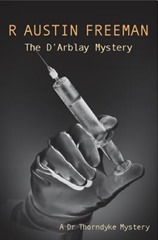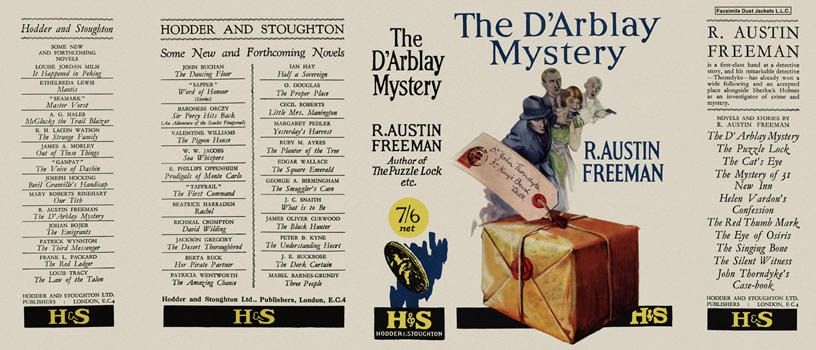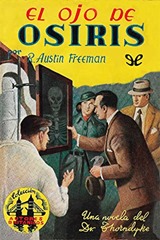Esta entrada es bilingüe. Desplazarse hacia abajo para acceder a la versión en español
House of Stratus, 2011. Book Format: Kindle Edition. File Size: 797 KB. Print Length: 219 pages. ASIN: B005MGRKEQ. ISBN: 9780755128211. First UK edition by Hodder & Stoughton, London, 1926 and first US edition by Dodd, Mead & Company, New York, 1926.
 Description: When a man is found floating beneath the skin of a green-skimmed pond one morning, Dr Thorndyke becomes embroiled in an astonishing case. This wickedly entertaining detective fiction reveals that the victim was murdered through a lethal injection and someone out there is trying a cover-up.
Description: When a man is found floating beneath the skin of a green-skimmed pond one morning, Dr Thorndyke becomes embroiled in an astonishing case. This wickedly entertaining detective fiction reveals that the victim was murdered through a lethal injection and someone out there is trying a cover-up.
My Take: The action unfolds twenty years ago and the story is narrated in the first person by Dr Stephen Gray himself. At that time he was a young medical doctor who just finished his studies and was about to start his professional practice. In fact the story begins on his last day off before his first job. For this reason, he decided to spend the day collecting specimens for his study. Consequently, he chose a pond in a woodland area near Wood Lane in Highgate to take samples. While being absorbed on this task, he saw the face of a dead man, submerged in the water, showing to the surface. Disconcerted, he tried to walk away when he came across with a beautiful young woman who, shortly before, had set him his attention. The young woman, Marion D’Arblay, was looking for her father who, contrary to his habit, had not returned home the night before. In this way, the corpse in the pond is soon identified as the girl’s father. At first glance, it looked like it could have been an accident or a suicide, but the autopsy demonstrated, with absolute certainty, that he had been murdered by a lethal injection. The case, however, was offering few leads to follow. D’Arblay had no known enemies, he lived alone with his only daughter and a housekeeper, and he led an orderly life. Dr Gray became determined to help Miss D’Arblay in any way he can and, therefore, he went to see Dr Thorndyke, who had teach him Medical Jurisprudence and was one of the greatest living authorities on the subject, for help and advice. Mr D’Arblay was a sculptor by profession, though lately he was working as a modeller for various trades –pottery manufacturers, picture-frame makers, and makers of high-class wax figures for shop windows.
Buoyed by Jim Noy’s reviews, I’ve read a couple of R. Austin Freeman’s books, though out of order. I chose to read The D’Arblay Mystery when I found out it was one of the best books in Dr Thorndyke mystery series, and it certainly lives up to the expectations generated. The story is quite solid and the plot is tightly crafted; the characters have seem to me truly convincing and appealing. And, to round it off, the investigation is carry out in a competent and professional manner. A book worth reading which I strongly recommend.
As a side note, I would like to point out once again the resemblance that, in my view, bears with Dorothy L. Sayers’ Unnatural Death.
The D’Arblay Mystery has been reviewed, among others, by Jim Noy at The Invisible Event, dfordoom at Vintage Pop Fictions, Nick Fuller at The Grandest Game in the World.
(Source: Facsimile Dust Jackets LLC. Hodder & Stoughton (UK), 1926)
(Source: Facsimile Dust Jackets LLC. Dodd, Mead & Company (USA), 1926)
About the Author: Richard Austin Freeman, (1862 – 1943), was a popular English author of novels and short stories featuring the fictional character John Thorndyke, a pathologist-detective. Educated as a physician and surgeon, Freeman practiced in the Gold Coast (now Ghana), where he caught a fever. Eventually forced by ill health to retire from practice (1904), he began to write fiction. The Red Thumb Mark (1907) was the first book in which he introduces Dr Thorndyke who will return to feature in a total of 21 novels ad 40 short stories. Within a few years he was a full-time writer. With the publication “The Case of Oscar Brodsky” (1910), a short story, he invented the inverted detective story. Thereafter he used some of his early experiences as a colonial surgeon in his novels. A large proportion of the Dr Thorndyke stories involve genuine, but often quite arcane, points of scientific knowledge, from areas such as tropical medicine, metallurgy and toxicology. A full list of novels and short stories can be found at Wikipedia.
Recommended Works: John Thorndyke’s Cases s.s. [US title Dr. Thorndyke’s Cases] (collected 1909); The Eye of Osiris [US title The Vanishing Man] (1911); The Singing Bone s.s. [US title The Adventures of Dr Thorndyke] (collected 1912); The Mystery of 31 New Inn (1912); A Silent Witness (1914); Dr Thorndyke’s Casebook s.s. [US title The Blue Scarab] (collected 1923); The Cat’s Eye (1923); The Puzzle Lock s.s. (collected 1925); The Shadow of the Wolf (1925); The D’Arblay Mystery (1926); The Magic Casket s.s. (collected 1927); As a Thief in the Night (1928); Mr Pottermack’s Oversight (1930); When Rogues Fall Out aka Dr Thorndyke’s Discovery (1932); The Penrose Mystery (1936); Felo De Se? aka Death at the Inn (1937); The Stoneware Monkey (1938); and The Jacob Street Mystery aka The Unconscious Witness (1942).
There are in total some 42 short stories featuring Dr John Thorndyke. Thirty-eight were published in the five short story collections mentioned above (John Thorndyke’s Cases; The Singing Bone; Dr Thorndyke’s Casebook; The Puzzle Lock and The Magic Casket. Two other stories featuring John Thorndyke, “The Missing Mortgagee” and “Percival Bland’s Proxy”, were published in the collection, The Great Portrait Mystery and other Stories alongside five further stories. There are also two further Thorndyke short stories, neither of which was published during Freeman’s lifetime. “31, New Inn”, written about 1905, was later reworked into a full-length novel, The Mystery of 31 New Inn, but was published in short story form in the 1973 collection, The Best Dr Thorndyke Detective Mysteries (edited by E F Bleiler). The final Thorndyke short story, “The Dead Hand” (which Austin Freeman later reworked into the novel, The Shadow of the Wolf) was published in the collection The Dead Hand and Other Short Stories (edited by Douglas G Greene and Tony Medawar) in 1999 and in Detection By Gaslight, a collection of Victorian detective stories by various authors, in 1997.
The House of Stratus publicity page
Meet Dr Thorndyke by R Austin Freeman
R. Austin Freeman by Mike Grost
R. Austin Freeman at Golden Age of Detection Wiki
The D’Arblay Mystery, de R. Austin Freeman
Descripción: Cuando una mañana un hombre aparece flotando bajo la superficie de un estanque de color verde desnatado, el Dr. Thorndyke se ve envuelto en un caso asombroso. Esta investigación policial diabólicamente entretenida desvela que la víctima fue asesinada mediante una inyección letal y que alguien allí afuera está tratando de encubrirlo.
Mi opinión: La acción se desarrolla hace veinte años y la historia está narrada en primera persona por el propio Dr. Stephen Gray. En ese momento era un joven médico que acababa de terminar sus estudios y estaba a punto de iniciar su práctica profesional. De hecho, la historia comienza en su último día libre antes de su primer trabajo. Por esta razón, decidió pasar el día recolectando especímenes para su estudio. En consecuencia, eligió un estanque en un área boscosa cerca de Wood Lane en Highgate para tomar muestras. Mientras estaba absorto en esta tarea, vio el rostro de un hombre muerto, sumergido en el agua, que asomaba a la superficie. Desconcertado, trató de alejarse cuando se cruzó con una hermosa joven que, poco antes, le había llamado la atención. La joven, Marion D’Arblay, buscaba a su padre que, contrariamente a su costumbre, no había vuelto a casa la noche anterior. De esta forma, el cadáver en el estanque pronto es identificado como el padre de la muchacha. A primera vista, parecía que podría haber sido un accidente o un suicidio, pero la autopsia demostró, con absoluta certeza, que había sido asesinado mediante una inyección letal. El caso, sin embargo, ofrecía pocas pistas a seguir. D’Arblay no tenía enemigos conocidos, vivía solo con su única hija y un ama de llaves, y llevaba una vida ordenada. El Dr. Gray se decidió a ayudar a la Srta. D’Arblay en todo lo que pudiera y, por lo tanto, fue a ver al Dr. Thorndyke, quien le había enseñado Jurisprudencia Médica y era una de las mayores autoridades vivas en el tema, en busca de ayuda y consejo. El Sr. D’Arblay era escultor de profesión, aunque últimamente trabajaba como modelista para varios oficios: fabricantes de cerámica, fabricantes de marcos y fabricantes de figuras de cera de alta calidad para escaparates.
Animado por las reseñas de Jim Noy, he leído un par de libros de R. Austin Freeman, aunque desordenados. Elegí leer The D’Arblay Mystery cuando descubrí que era uno de los mejores libros de la serie de misterio del Dr. Thorndyke, y ciertamente está a la altura de las expectativas generadas. La historia es bastante sólida y la trama está bien elaborada; los personajes me han parecido realmente convincentes y atractivos. Y, para rematar, la investigación se lleva a cabo de manera competente y profesional. Un libro que vale la pena leer y que recomiendo encarecidamente.
Como nota al margen, me gustaría señalar una vez más el parecido que, en mi opinión, guarda con Unnatural Death de Dorothy L. Sayers.
Acerca del autor: Richard Austin Freeman, (1862 – 1943), fue un popular autor inglés de novelas y relatos protagonizados por el personaje de ficción John Thorndyke, un patólogo-detective. Educado como médico y cirujano, Freeman ejerció en Costa de Oro (ahora Ghana), donde cogió unas fiebres. Finalmente, obligado por problemas de salud a retirarse de la práctica médica (1904), comenzó a escribir novelas y relatos de ficción. The Red Thumb Mark (1907) fue el primer libro en el que presenta al Dr. Thorndyke, quien volverá a aparecer en un total de 21 novelas y 40 relatos breves. A los pocos años se dedicó a escribir a tiempo completo. Con la publicación de “El caso de Oscar Brodsky” (1910), un relato breve, inventó la historia de detectives invertida. A partir de entonces utilizó algunas de sus experiencias iniciales como cirujano colonial en sus novelas. Una gran proporción de las historias del Dr. Thorndyke comportan aspectos genuinos de conocimientos científicos, pero a menudo bastante desfasados, sobre especialidades tales como medicina tropical, metalurgia y toxicología. En Wikipedia se encuentra un listado completo de sus novelas y relatos.
Obras recomendadas: John Thorndyke’s Cases (1909), en USA Dr. Thorndyke’s Cases; El ojo de Osiris (The Eye of Osiris, 1911; en USA The Vanishing Man); El caso de Oskar Brodski (The Singing Bone, 1912; en USA The Adventures of Dr. Thorndyke); The Mystery of 31 New Inn (1912); Un testigo silencioso (A Silent Witness, 1914); Dr. Thorndyke’s Casebook (1923), en USA The Blue Scarab; El secreto del colgante (The Cat’s Eye, 1923); The Puzzle Lock (1925); The Shadow of the Wolf (1925); The D’Arblay Mystery (1926); The Magic Casket (1927); As a Thief in the Night (1928); El cuento del Dr. Thorndyke (Mr. Pottermack’s Oversight, 1930); When Rogues Fall Out (1932), en USA Dr. Thorndyke’s Discovery; El enigma de Penrose (The Penrose Mystery, 1936); ¿Suicidio? (Felo de Se, 1937; en USA Death At The Inn); El mono de barro (The Stoneware Monkey, 1938); The Jacob Street Mystery (1942), en USA The Unconscious Witness.










